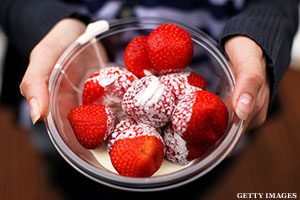By Arthur Bovino
TheDailyMeal.com
You've heard the story before. An assistant coach of a struggling team at the University of Florida sits down with university physicians and together they devise a drink that turns around its season. From being sipped in dugouts and by NBA hardwood royalty to being doused over winning Super Bowl coaches, Gatorade has gone on to become inextricably linked with all sports forevermore. So as you're watching this year's MLB All-Star Game and hankering for some roasted peanuts, remember how this and other iconic sports food got their starts.
Some of these foods and drinks, like Gatorade, were originally conceived with sports in mind. For example, Big League Chew was actually the brainchild of actual athletes -- two pitchers talking in a bullpen in the minors no less. Other iconic foods associated with sports, like Wheaties, weren't invented with any athletic endeavors in mind, but are so linked to them that it's almost impossible to think about them in any other way.
Then there are the legendary food and drinks that are associated with very specific sports locations and special events -- like Gilroy garlic fries at AT&T Park in San Francisco; Dodger Dogs in Los Angeles; mint juleps, hot browns, and burgoo at the Kentucky Derby.
These legendary foods are so iconic that some, like garlic fries have even spawned imitators. At Yankee Stadium they've become so synonymous with the experience in the Bronx that young fans might not know they weren't invented there. (There's a whole generation of Long Island Mets fans who likely think Shake Shack is the only good thing their team "invented.") Some food and drinks, like juleps, are so loved, and iconic that they spill out of the confines of the stands and onto menus everywhere.
Whether it's between moments on the field, at stadiums, on television, or on the breakfast table, here are some of the most iconic sports foods and how they found their place.

The list:
• Wimbledon: Strawberries and Cream
During Wimbledon more than 20 tons of fruit (more than two million berries) and 1,820 gallons of cream are consumed as the event's signature dish, strawberries and cream, is consumed. Tennis and strawberries ... why this bizarre combination? Legend dictates that King George V is responsible, but as The New York Times reported, the tradition dates to the era of the first Wimbledon tournament in 1877. Strawberries and cream were fashionable to eat and the seasonality coincided with the event.
Wimbledon's other iconic culinary icon, while its association is younger, is certainly more spirited. Champagne was Wimbledon's original beverage of choice, but the Pimm's Cup is better known now. The first Pimm's bar at Wimbledon opened in 1971. Its popularity grew and today more than 80,000 pints of Pimm's and lemonade are sold there annually.
•Cracker Jacks
F.W. Rueckheim introduced Cracker Jack at the World's Columbian Exposition in Chicago in 1893. His brother supposedly gave the snack to a salesman, who proclaimed, "That's a Cracker Jack!" But Cracker Jack's link to baseball has a lot to do with two other men -- Jack Norworth and Albert Von Tilzer -- the writer and composer of "Take Me Out To The Ballgame." The free publicity has been helping sales ever since. Ironic considering they supposedly didn't make it to a game until about 20 years after writing the song.
• Big League Chew
While trying to make a comeback in 1977 with the Portland Mavericks, pitcher Jim Bouton was sitting in the bullpen with teammate Rob Nelson who noted it was too bad someone didn't make gum that looked like chewing tobacco. When the season was over Bouton put money behind the idea, designed a pouch, and made some gum that they chopped up. Amurol Products, a novelty gum company in Illinois, launched Big League Chew in 1980 and sold $18 million at wholesale. As Bouton's site notes, the gum still sells today, having (thankfully) replaced chewing tobacco at many high schools and colleges.

• Buffalo Wings
Think of every Super Bowl party you've ever hosted or attended. Consider any bar fare you've ever consumed while watching a game. What's the most iconic? If you said "beer," it would be difficult to argue. But with that you'd probably identify Buffalo wings as one of the most iconic sports foods ever.
Buffalo wings were invented by Teressa Bellissimo in 1964 and were first served at a family-owned spot in Buffalo called Anchor Bar. Bellissimo covered wings in a special sauce and served them with blue cheese and celery because she had them on hand. As Time noted, there are at least two origin stories. The first has Teressa coming up with the idea after receiving an accidental shipment of wings. The second, from her son Dominic, claims they were a midnight snack she created at his request. The Bellissimos have since passed away, but the dish isn't going anywhere.
• Gilroy Garlic Fries
They're one of the best and most iconic stadium foods in America, the Gilroy garlic fries at AT&T Park in San Francisco. Their invention is credited to Dan Gordon of Gordon Biersch who created the garlic and fry combination as a late night snack during finals in grad school. The concession stands in the ballpark are infamous for the marvelous smell of stinking rose that wafts from them.
There are quality imitators, like at Yankee Stadium, but they haven't caught on to a smart garlic fry concession move in San Francisco: multiple locations. At AT&T the fries are on Promenade Level Sec. 103, 118, 130; View Level Sec. 311, 323, 331; Field Level; and Lower Center Field. There's just one crowded stand with long lines in the Bronx.
• For complete list and slideshow of iconic sports food, go to TheDailyMeal.com.
More from TheDailyMeal.com:
-- 20 Best Sports-Crazy Restaurants
-- 10 Successful Vegetarian Athletes
-- The Best Stadium Luxury Box Food Spreads





